Mark Newport
Embroidered Work
Knitted Work
Prints
Photography - Prints
About
Exhibitions
New Work, January 7 – February 13, 2010
Ready for Action: Recent Digital Editions, September 7-30, 2006
New Work, August 5-28, 2004
Embroidered Comic Book Cover Samplers, December 7-30, 2001
Sculpture, February 4 -27, 1999
-
Mark Newport was born in 1964 in Amsterdam, New York. Newport received his BFA from the Kansas City Art Institute in 1986, and obtained his MFA from the School of the Art Institute of Chicago in 1991. He was included in “Staged Stories” at the Renwick Museum of American Art at the Smithsonian Institute in Washington, DC; “Superheroes and Secret Identities,” at the Sun Valley Center for the Arts in Sun Valley, Idaho; and “Un-Knitting” at The Stanlee and Gerald Rubin Fine Arts Center, University of Texas in El Paso. He lives in Michigan and teaches at Cranbrook Academy of Art.
Link to Mark Newport’s website
-
-
January 7, 2010
Seattle Metropolitan Magazine
“The Weekend Starts Now: Met Picks”
by Laura DannenJanuary 8, 2010
The Stranger
“Currently Hanging: Mark Newport”
by Jen GravesDecember 2009
American Craft, Vol 69, No 6
“Staged Stories”
by Sarah TanguyJune 25- September 3, 2005
Arizona State University Art Museum, Nelson Fine Arts Center
MARK NEWPORT: Super Heroics
by John D. Spiak, Curator“For centuries, knitting has been associated with the feminine -- from medieval portraits of the Virgin Mary beatifically purling to Grandma's treasured knit afghans. Arizona artist Mark Newport, however, views knitting and related domestic textile arts in quite a different way. For him, they are symbols for understanding masculinity and brute strength -- and the unlikely means by which he is able to create the iconic wardrobes of the superhero. Through methods traditionally associated with female cultural identity, Newport expresses his own ideas about male identity in American society in this, the very first museum solo exhibition of his work. (One of Newport's bedcover quilts is illustrated at right)
“Born in 1964, Mark Newport grew up during the late 60s, when the after-school television viewing habits of many young American boys revolved around the world of Batman and other comic superheroes of the time. Like most children of his generation, the artist was hooked on these larger-than-life champions of right and good. In retrospect, he admits that he seemed to like the Batman-type heroes the best -- the darkness, the loner, the ones that relied on gadgets more than invincible strength. He was less fond of Superman and patriotic-crusader types, gravitating instead to those who seemed a bit more human and vulnerable.
“The world of comic books fascinated the artist, but not for the heroic storylines and awe-inspiring super powers reasons that they interested most kids of his generation. Newport was more interested in the drawing techniques of the artists who created these comics and in the visual language that existed within their pages. Their seductive power lay in the comic artist's creation of identity through appearance and suggested strength.
“In his pre-teens, as with most young boys reaching that age, the artist's interests shifted. Fascination with the fantasy world of comics began to give way to that of human heroes embodied by the rock star and athletic stars of the baseball and football worlds. Collecting baseball and football cards soon became his new passion.
“After receiving his Bachelor of Fine Arts degree from Kansas City Art Institute in 1986, Newport pursued a Master of Fine Arts at the School of the Art Institute of Chicago. It was there he became more familiar with and influenced by such feminist icons as writer Andrea Dworkin, artists Eva Hesse and Louise Bourgeois, and the Chicago-based Hairy Who, which was a primarily male dominated group of artists that first appeared in the early 1960s. He was developing his artistic voice at a time in which the art world was focused on multiculturalism and the backlash against the art-star filled, white male artist-driven world. Tuning into this, Newport began making abstract sculpture works examining issues of gender and male identity in an attempt to better understand the issues being discussed in the contemporary art scene at that time.
“In 1994, returning to the icons with which he was familiar, he started using imagery connected with the sports heroes emblazoned on trading cards. He began to embroider on and then bead the individual cards, first those of sports figures, then on Desert Storm (at left), pin-up and porn star trading cards. Newport explains that the trading cards were more of a decorative critique of maleness using a beading process. They dealt with gender issues, but were very abstract in concept. [I]t was an exploration of the outer skins or shells of identity, void of the knowledge of the inner workings. Eventually he began working the process upon comic book covers, leading to his Comic Book Quilts and Samplers series.
“When Newport felt the trading cards and comic book series had reached a certain peak, he began to look for different forms with which to work, which coincided with the artist being in a different psychological place in his life. He was now a young father of two and began to examine his role in his own children's lives. According to Newport, his own father always said he was Superman, reflecting most children's belief that their parents can do anything. Questions about how others, especially his children, perceived him drew the artist's interest, compelling him to develop new approaches that not only looked at outward manifestations of gender identity, but ones that explored the very core of that identity.
“It was at that point Newport began to find his current artistic voice, which reaches back to a time that was influential in the development of his own masculinity, to the visuals and identities he first referenced as "hero". As a youngster, Newport had learned to knit from his grandmother but he had forgotten how. Over a three-year period, with the help of his wife and pattern instructions he found on the Internet, the artist relearned the art of knitting. He began to use this rediscovered knowledge to create the hand-knit superhero costumes (at right) that are part of ASU Art Museum's current exhibition, Super Heroics.
“Turning the superhero inside out is a way for me to present an understanding of masculinity, says Newport. Superheroes suggest strength, but knitting them or covering them with embroidery provides a softness that is contradictory to their image. Like the mild-mannered exteriors of superhero alter-egos Bruce Wayne and Clark Kent, who morph into Batman and Superman respectively, these are not the trappings of rough-and-tough, super-powered individuals, but rather of Everyman, the common male who plays his role in life with integrity, gentility and reliable consistency -- characteristics of masculinity often undervalued in our society.
“The works in the exhibition are familiar to the viewer, drawing upon classic figures of pop cultural superhero identities from Superman and Batman to lesser known, more contemporary figures such as The Escapist (from Michael Chabons novel, The Amazing Adventures of Kavalier and Clay) , as well as more autobiographical created figures as Sweaterman (2005) and Sweaterman: Cable (2005). These outer shells, which tie in to Newport's early body of work, now take on full human scale, yet are stripped of their references to tough inner personae, ripped body muscles and superhuman physical strength usually associated with the characters donning them. Instead, Newport's superhero costumes hang limply in the gallery, allowing the viewer to psychologically create the complex identities that would fill such a costume, or perhaps fantasize about one's own body filling that void. Essentially, Newport's costumes are skins waiting to be brought to life.
“Newport's newest work, a series of ink jet prints created from photographic self-portraits, emphasize the paralyzing lack of confidence in one's ability to have an appreciable affect on the outside world. Works like He Could Help (2005), SSSK (2005)(at left), and Knitting a Forcefield 1 (2005) all represent the protective shields we place around ourselves, our barriers against personal involvement when others are in need of help. Known in sociological terms as the Bystander Effect , this phenomenon is defined as the belief that individuals do not get involved in helping others because they feel that someone else is better suited to respond, the undertaking may be too dangerous, or that others will take care of the situation.
“Newport's art compels us to re-examine the nature of a super-heroic act within the context of contemporary society. For Newport, it does not involve stopping a speeding train, preventing a natural disaster, or saving the world from crime; rather, it consists of acting upon everyday opportunities to be present for others, at the right time with the right gesture, through which one becomes a hero in someone else's eyes.”
- John D. Spiak, CuratorFriday, August 20, 2004
Seattle Times
“Thought-Provoking Imaginary Worlds at Greg Kucera Gallery”
by Matthew Kangas“Two young artists, Mark Newport and Tim Roda, have sensational new shows at Greg Kucera Gallery this month. Although both interpret the human figure, they are very different.
“Newport hand-knits larger-than-life costumes of comic-book superheroes and meticulously beads and embroiders comic-book covers. Roda creates ominous black-and-white photographs of adults and children in bizarre, cluttered interiors. Together, they present two of the most thought-provoking and visually compelling exhibits of the summer.
“Astoundingly, Roda, 27, just finished at the University of Washington graduate school of art. Already a mature artist with a complex, deepening vision of parent-child relationships and the artificially constructed nature of photography, Roda's solo debut is a major event. His completely original talent slyly draws in the viewer with oddly lit scenes of people in cramped and crowded domestic environments. Cheesy patterned wallpaper, skewed corners with deep perspectives and facial expressions of fear and confusion combine to disturb and unbalance the unsuspecting viewer.
“What is going on in these pictures? Dream worlds of animals, toys and garage-sale remnants are the theatrical props for the people Roda situates in confining sites. Using family members and friends like actors, the photos distantly recall Sally Mann and Diane Arbus, famous black-and-white photographers whose work seems to prey upon the innocent models as much as on the viewer.
“As a result, the stories implied within each shot are enigmatic and multi-layered, like a Faulkner short story. Roda's artistry is such, however, that precise titles like "The Last Italian Supper with My Mother" or "The Farmer, the Wife, My Mom and Me" (both 2004) deceive us into thinking these are part of real life. Far from it, the complicated compositions with diagonal wood scraps, windows and doors, and draped cloth make up a completely imaginary world that one wants to observe but is afraid to enter.
“Newport's vision goes to the heart of teenagers' fantasies mediated by popular culture. Looking at his laboriously embroidered superhero comic-book covers and the brilliantly colored head-to-toe costumes of Batman, Aquaman, Spiderman and the others, visitors are brought back down to earth after the hushed and tense world of Roda's characters.
“Now associate professor of art at Arizona State University, Newport, 40, has been included in prestigious museum surveys in California, New York, Illinois, Texas and Switzerland. This is his 10th solo show since 1996 and his third (and best) at Kucera.
Exhibit Review
“The "Superheroes" hang limply on the wall or, in a few cases, are suspended from the ceiling. Thus, Spiderman, Ironman, Daredevil and others come alive with the brittle colors of the acrylic yarn and slightly oversize dimensions. Tallest of the lot at 10 feet high, "Fantastic Four (Reed Richards)" (2003) goes beyond normal human size to a weirdly stretched effigy that delights and disturbs at the same time.
“Comic-book addicts will love Newport's homages, but so will those interested in the new frontiers of traditional craft materials like thread and fiber. Not using a knitting machine, Newport's painstaking efforts to do justice to his superheroes will be appreciated on many levels.
“The same is true of the embellished comic-book covers. Like medieval illuminated manuscripts, certain areas in each are highlighted for special treatment. "Lois Lane" (2003), "Catwoman and Batman" (2003) and the new gay comic-book hero, "Rawhide Kid" (2004), are especially beautiful.”
Copyright 2004 The Seattle Times CompanyAugust 18 - 24, 2004
Seattle Weekly
“Visual Arts Pick”
by Suzanne Beal“Using embroidery and knitting, Mark Newport wields his needles to address the stereotyped facade of the he-man, the tough guy, and the superhero. In a series of framed samplers, the artist underscores key elements from the covers of comic books, using the satin, the stem, and the ubiquitous backstitch to embroider over them. But it's Newport's hand-knit superhero costumes that tie the show together. Well-known classics such as Spider-Man (shown here), Batman, and The Fantastic Four hang alongside lesser-known models such as The Escapist (from Michael Chabon's novel The Amazing Adventures of Kavalier and Clay) and the hooded Patriot, a red-white-and-blue invention of the artist. Unlike their comic-book incarnations, in which the superheroes' attire seems permanently affixed to muscles that ripple under lean flesh, Newport's lifeless hand-knit suits line the walls of the gallery and float from the ceiling on invisible threads that allow them to limply sway in the breeze. By exhibiting the wolf's clothing without the sheep, Newport exposes the superhero as fraud and demonstrates that growing into manhood may not require leaping over tall buildings but rather passing through the eye of a needle.”
Copyright 2004 The Seattle Weekly












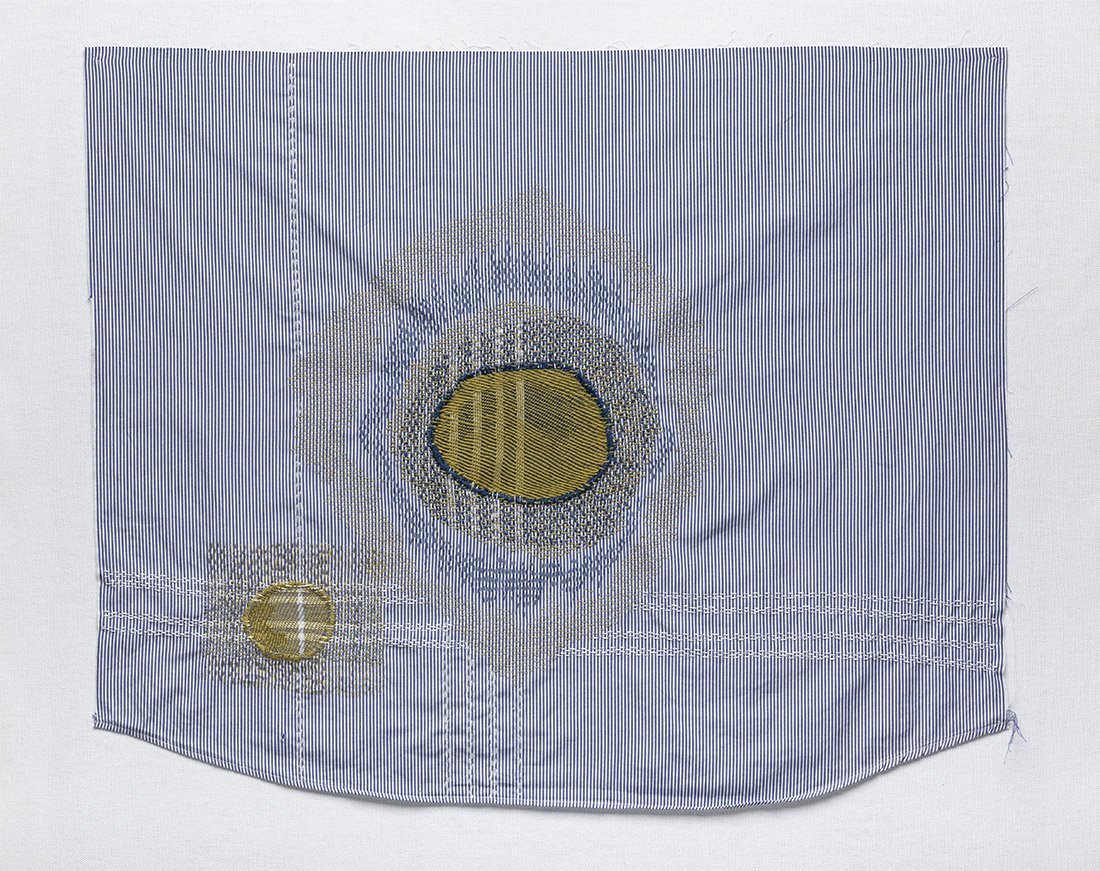
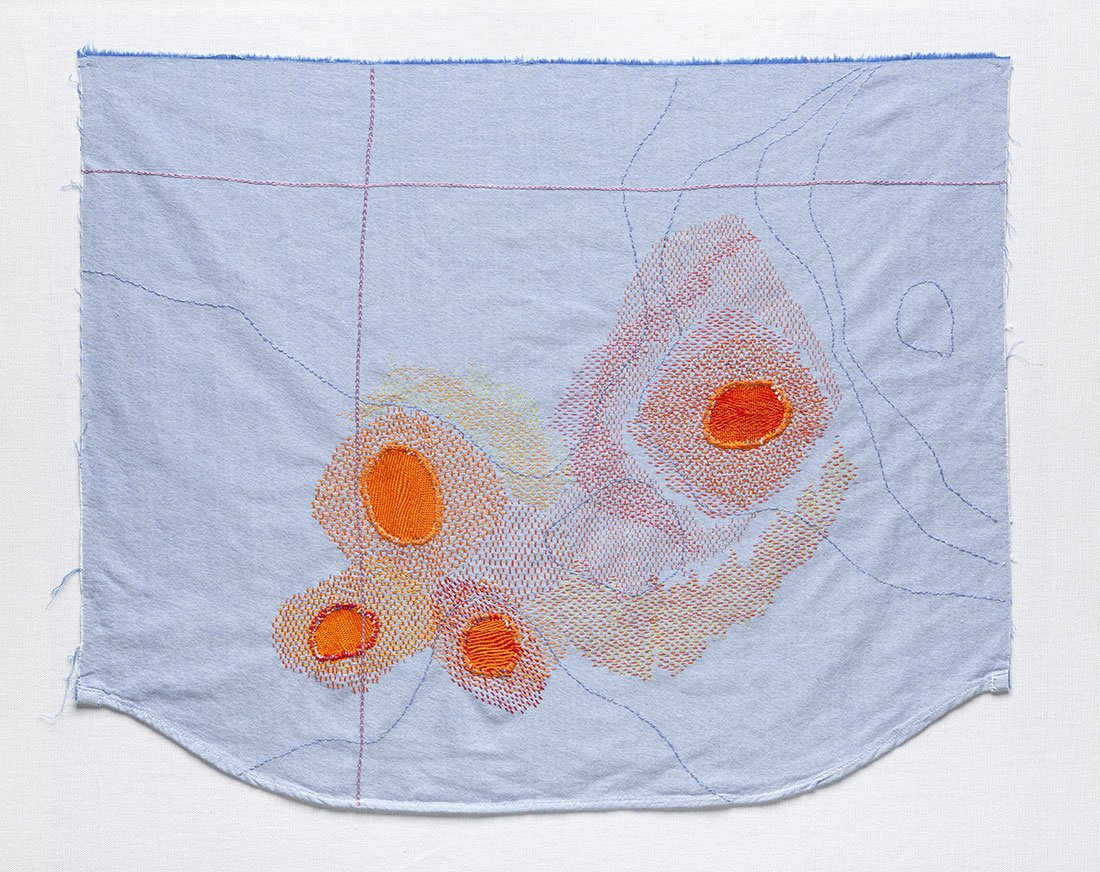
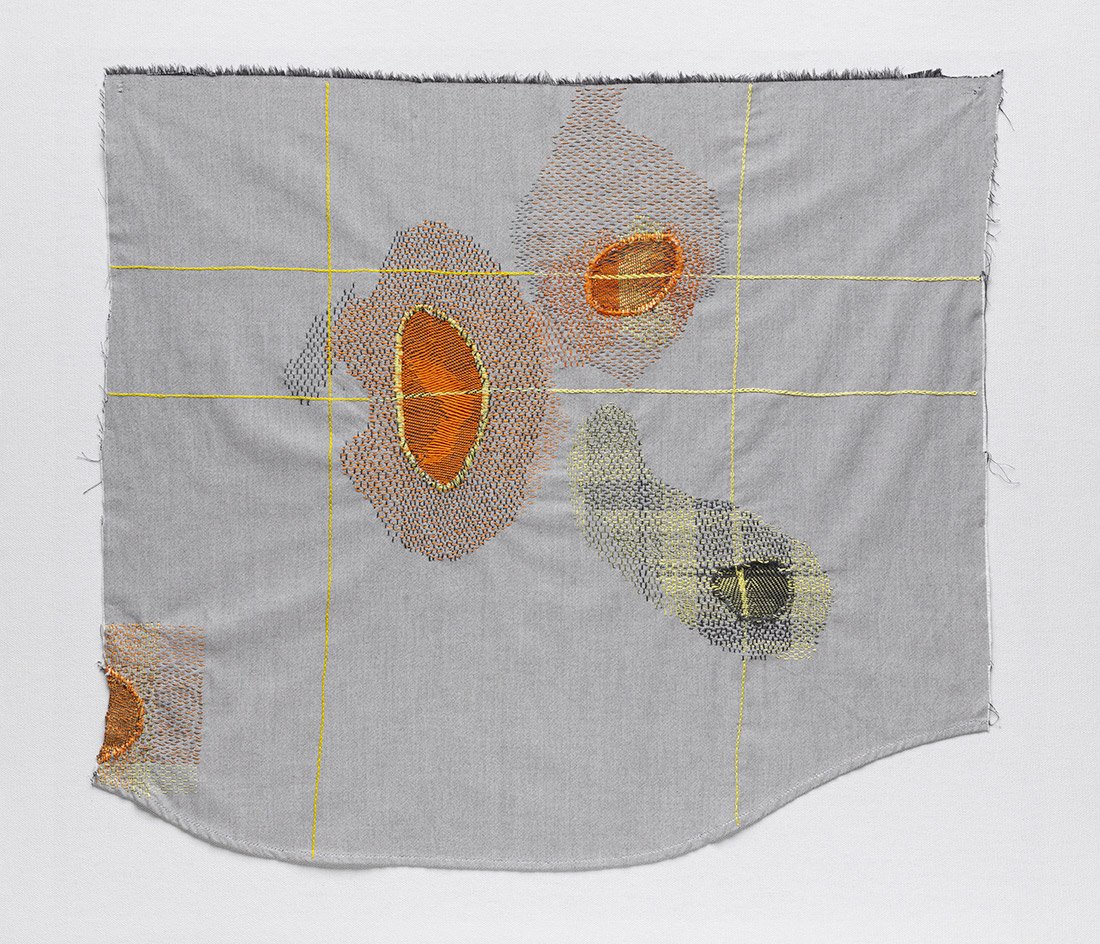













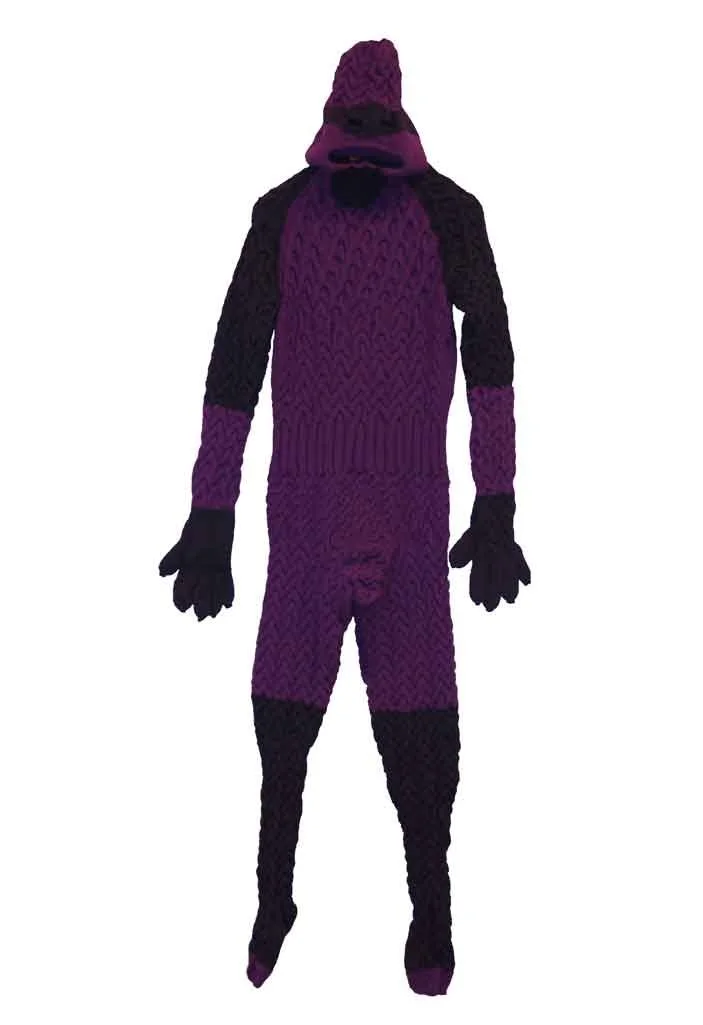

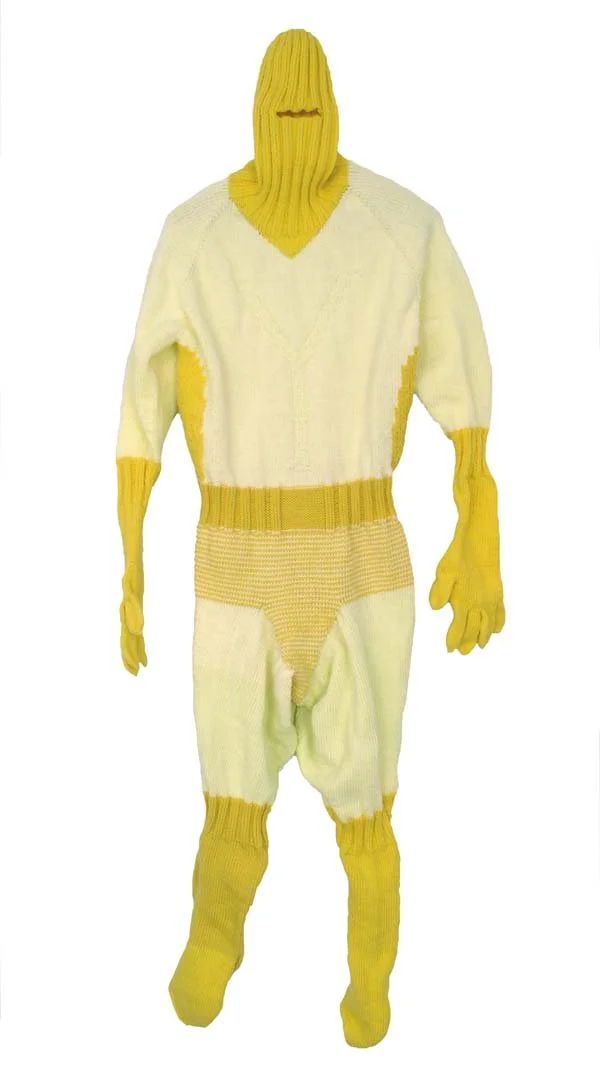
























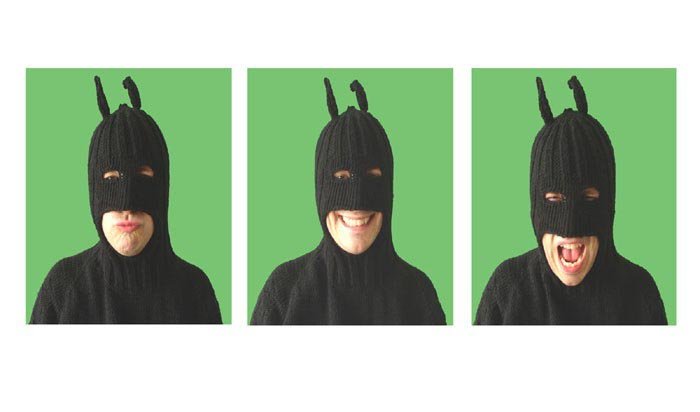






















Embroidered comic book cover
10.25 x 6.75 inches
$3,400 (framed)